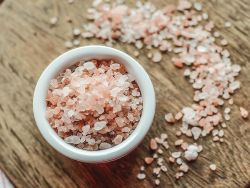Salt has been used for a long time to preserve food and features in the majority of bread recipes. Its earliest recorded use dates back to China in 2700BC. So what is the importance of salt when it comes to making bread and does salt keep bread fresh?
Salt keeps bread fresh by controlling the water activity in the dough. Staling and retrogradation of bread are largely related to the moisture content in the bread. The more salt that is present, the less likely water will evaporate from the crust of a loaf. This is where staling begins.
There are many other complex mechanisms involved in staling that need to be considered.
How does bread go stale?
Bread will always go stale because of starch and gluten modifications, these aid the retrogradation of the starch. This is when the amylose and amylopectin chains in gelatinized starch realign themselves as they cool.
Let’s see how salt improves the keeping quality of bread!
How does salt stop bread from going stale
Salt has been a preservative for centuries and is capable of extending the life of bread. It does this by reducing the activity of the water to slow the regeneration of the starch.
Retains moisture
Salt makes it hard for water molecules to migrate through the bread. The bread stores more water in the crumb structure which prevents moisture from evaporating.
Salt does not prevent staling completely, but it does control the water activity in the dough. The less salt that is present, the more likely moisture will evaporate from bread and prevent staling to occur.
Less recrystallization
Large Na+ ions are entrapped in the dough which takes up space that the small H+ ions need. This reduces the recrystallization of starch.
Shelf life
The growth of microbial activity increases when less salt is used in the dough. This decreases the shelf life of the bread. For maximum shelf life, enough salt should be added to the dough.
High water activity = faster microbial growth
The use of salt increases osmotic pressure. This causes the bread to lose water and also slows down microbial growth in the water. This lower water activity keeps the bread fresher for longer.
Using water from different areas or switching to bottled water can also have an impact on shelf life. Water that has a high amount of activity will provide more microbial bacteria for the yeast thus making it rise quicker. But it will also stale quicker which is why you might consider tweaking the amount of salt you use in different areas.
How do I know if I have high water activity?
Water with high amounts of activity is often classed as “hard water”. You’ll be able to know more if you contact your local water supplier. Bottled water tends to also be hard water.
If I add more salt will my bread keep fresher?
If there is more salt present it will decrease the water activity in the dough. This means that there will be less evaporation of moisture from the bread, and a lower rate of staling occurs. Therefore, adding more salt makes bread stay fresh for longer.
How much salt should I use in bread?
Typically 1.8-2% of salt to the total flour weight is used to make bread. Increasing the amount of salt will slow the fermentation process of the yeast and produce an overly salty flavour.
In my what is the purpose of salt in bread article I explain why this is the perfect ratio of salt? Using less salt than this will weaken the dough structure, alongside increasing the speed at which the bread goes stale. Read my salt in bread article to find out more!
If you’ve enjoyed this article and wish to treat me to a coffee, you can by following the link below – Thanks x

Hi, I’m Gareth Busby, a baking coach, senior baker and bread-baking fanatic! My aim is to use science, techniques and 15 years of baking experience to make you a better baker.
Table of Contents
Related Recipes
Related Articles
Latest Articles
Baking Categories
Disclaimer
Address
53 Greystone Avenue
Worthing
West Sussex
BN13 1LR
UK










Leave a Reply